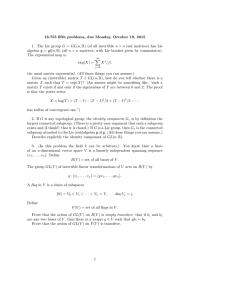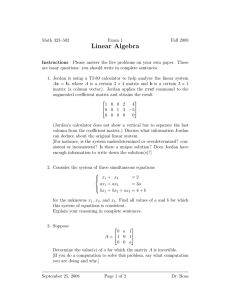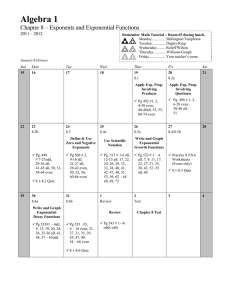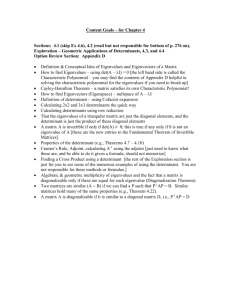18.755 fifth problem set solutions
advertisement
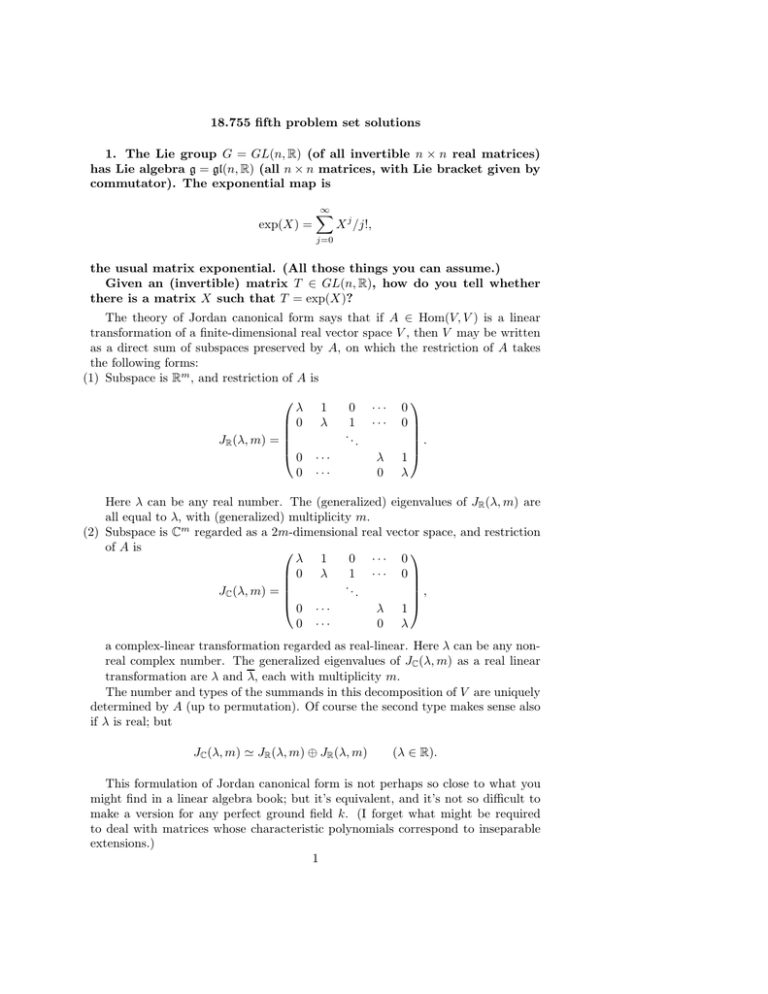
18.755 fifth problem set solutions
1. The Lie group G = GL(n, R) (of all invertible n × n real matrices)
has Lie algebra g = gl(n, R) (all n × n matrices, with Lie bracket given by
commutator). The exponential map is
exp(X) =
∞
X
X j /j!,
j=0
the usual matrix exponential. (All those things you can assume.)
Given an (invertible) matrix T ∈ GL(n, R), how do you tell whether
there is a matrix X such that T = exp(X)?
The theory of Jordan canonical form says that if A ∈ Hom(V, V ) is a linear
transformation of a finite-dimensional real vector space V , then V may be written
as a direct sum of subspaces preserved by A, on which the restriction of A takes
the following forms:
(1) Subspace is Rm , and restriction of A is
λ 1
0 λ
JR (λ, m) =
0 ···
0 ···
0
1
..
.
···
···
λ
0
0
0
.
1
λ
Here λ can be any real number. The (generalized) eigenvalues of JR (λ, m) are
all equal to λ, with (generalized) multiplicity m.
(2) Subspace is Cm regarded as a 2m-dimensional real vector space, and restriction
of A is
λ 1
0 ··· 0
0 λ
1 ··· 0
..
,
JC (λ, m) =
.
0 ···
λ 1
0 ···
0 λ
a complex-linear transformation regarded as real-linear. Here λ can be any nonreal complex number. The generalized eigenvalues of JC (λ, m) as a real linear
transformation are λ and λ, each with multiplicity m.
The number and types of the summands in this decomposition of V are uniquely
determined by A (up to permutation). Of course the second type makes sense also
if λ is real; but
JC (λ, m) ≃ JR (λ, m) ⊕ JR (λ, m)
(λ ∈ R).
This formulation of Jordan canonical form is not perhaps so close to what you
might find in a linear algebra book; but it’s equivalent, and it’s not so difficult to
make a version for any perfect ground field k. (I forget what might be required
to deal with matrices whose characteristic polynomials correspond to inseparable
extensions.)
1
2
In order to calculate the exponential of an arbitrary matrix X, we write it as a
sum of Jordan blocks and calculate the exponential of each block separately. This
is easy:
1 1
0 1
exp(JR (λ, m)) = eλ
0 0
1/2! 1/3! · · ·
1
1/2! · · ·
..
.
0
0
1/m!
1/(n − 1)!
.
···
1
It’s a pretty easy exercise to see that this matrix is conjugate to JR (eλ , m). That
is, each real Jordan block for X gives a real Jordan block for exp(X) with a strictly
positive real eigenvalue.
In exactly the same way, we calculate
exp(JC (λ, m)) ≃ JC (eλ , m).
Every nonzero nonreal complex number is the exponential of some nonreal complex number; so every complex Jordan block for a real invertible matrix is the
exponential of a complex Jordan block of the same size.
The tricky part is that eλ can be real even if λ is not. We find
exp((JC (a + 2qπi, m)) ≃ JR (ea , m) ⊕ JR (ea , m)
(q ∈ Z).
exp((JC (a + (2q + 1)πi, m)) ≃ JR (−ea , m) ⊕ JR (−ea , m)
(q ∈ Z).
In the first case, we are just getting a different way to write a matrix that we
already knew was an exponential. For GL(2, R), we now can write in two ways
I = exp
0 0
0 0
= exp
0
−2π
2π
0
.
But in the second case, we are seeing how to write as exponentials some matrices with negative eigenvalues, which previously we did not know how to do. For
example, for GL(2, R),
−I = exp(JC (iπ, 1)) = exp
0
−π
π
0
.
So here is the answer to the question in the problem: given an invertible matrix
T ∈ GL(n, R), change bases to write it as a sum of Jordan blocks as described
above. Then T can be written as an exponential if and only if for every negative
real eigenvalue of T , each Jordan block size occurs an even number of times. (For
matrices that are diagonalizable over C, the condition is just that every negative
real eigenvalue must have even multiplicity.) We’ve even said fairly explicitly how
to find a logarithm of T , from knowledge of the Jordan canonical form.
2. If G is any topological group, the identity component Ge is by definition
the largest connected subgroup. (There is a pretty easy argument that
such a subgroup exists and (I think!) that it is closed.) If G is a Lie group,
3
then Ge is the connected subgroup attached to the Lie (sub)algebra g of
g. (All those things you can assume.)
Describe explicitly the identity component of GL(n, R).
This is the subgroup generated by the image of the exponential map. I claim
that the subgroup generated by the image of exp consists of all matrices with strictly
positive determinant. Here is why. First we have to prove that everything in the
image of exp has strictly positive determinant. It’s enough to do this one Jordan
block at a time, since the determinant of a block diagonal matrix is the product of
the determinants of the blocks. The two calculations are
det JR (eλ , m) = emλ > 0
(λ ∈ R)
and
det JC (eλ , m) = |emλ |2 > 0
(λ ∈ C).
For the second, I talked a long time ago in class about the fact that if A is an m× m
complex matrix regarded as a 2m × 2m real matrix, then detR (A) = | detC (A)|2 .
Conversely, we want to show that if T is any matrix of positive determinant,
then it’s in the subgroup generated by the image of exp. Suppose first that S 2 = I
is a matrix having only the eigenvalues +1 and −1; say
R = V+ ⊕ V−
is the eigenspace decomposition of S. Then
det S = (−1)dim V+ .
If the −1 eigenspace is even dimensional, then the discussion in Problem 1 shows
how to write S as an exponential; so in that case it belongs to the identity component.
Now suppose T is arbitrary invertible. Write
Rn = W+ ⊕ W− ⊕ WC ,
with W+ the sum of the Jordan blocks for positive eigenvalues; W− the sum of the
Jordan blocks for negative eigenvalues; and WC the sum of the Jordan blocks for
nonreal eigenvalues. Then
sgn(det(T )) = (−1)dim W− .
Assume now that T has positive determinant, so that dim W− is even; we want
to show that T is in the subgroup generated by the image of exp. Define S to have
−1 eigenspace W− and +1 eigenspace W+ ⊕ WC . Then S is in the image of exp,
so it is enough to show that ST is in the image of exp. But the construction of
S shows that the eigenvalues of ST are precisely the eigenvalues of T , with the
negative ones replaced by their absolute values. Therefore every real eigenvalue of
ST is strictly positive, so (Problem 1 again) ST is an exponential (even one Jordan
block at a time).
We showed that anything in the identity component is a product of at most two
exponentials. This turns out to be true for any semisimple Lie group G. I’m not
certain whether it’s true for arbitrary Lie groups.
4
3. (In this problem the field k can be arbitrary.) You know that a basis
of an n-dimensional vector space V is a linearly independent spanning
sequence (v1 , . . . , vn ). Define
B(V ) = set of all bases of V .
The group GL(V ) of invertible linear transformations of V acts on B(V )
by
g · (v1 , . . . , vn ) = (gv1 , . . . , gvn ).
A flag in V is a chain of subspaces
{0} = V0 ⊂ V1 ⊂ · · · ⊂ Vn = V,
dim Vj = j.
Define
F (V ) = set of all flags in V .
Prove that the action of GL(V ) on B(V ) is simply transitive: that if b1
and b2 are any two bases of V , then there is a unique g ∈ V such that
gb1 = b2 .
Prove that the action of GL(V ) on F (V ) is transitive.
Since all n-dimensional vector spaces are isomorphic, we might as well assume
V = k n , thought of as column vectors. More precisely, we do this by sending the
basis b1 of V to the standard basis (e1 , e2 , . . . , en ) of k n .
An n × n matrix is a list of n vectors; the matrix g is invertible if and only if
the list of vectors is a basis of k n . That is, we can identify B(k n ) with GL(n, k).
In this identification, the basis b2 corresponding to g is precisely g · b1 , because the
columns of g arise by applying g to the standard basis vectors. This proves the
simple transitivity.
There is a natural map
B(V ) → F (V ),
(v1 , . . . , vn ) 7→ (hi ⊂ hv1 i ⊂ hv1 , v2 i ⊂ · · · ).
This map respects the action of GL(V ) on each set; that’s what “natural” means.
The map is surjective, because given a flag you can construct a basis step by step:
start with the empty basis of V0 , extend to a basis (v1 ) of V1 , then extend to a basis
(v1 , v2 ) of V2 , and so on. (This uses the fact that a basis of a subspace can always
be extended to a basis of the whole space.)
The surjectivity of the map and the transitivity of the GL(V ) action on B(V )
imply the transitivity of the action on F (V ).
